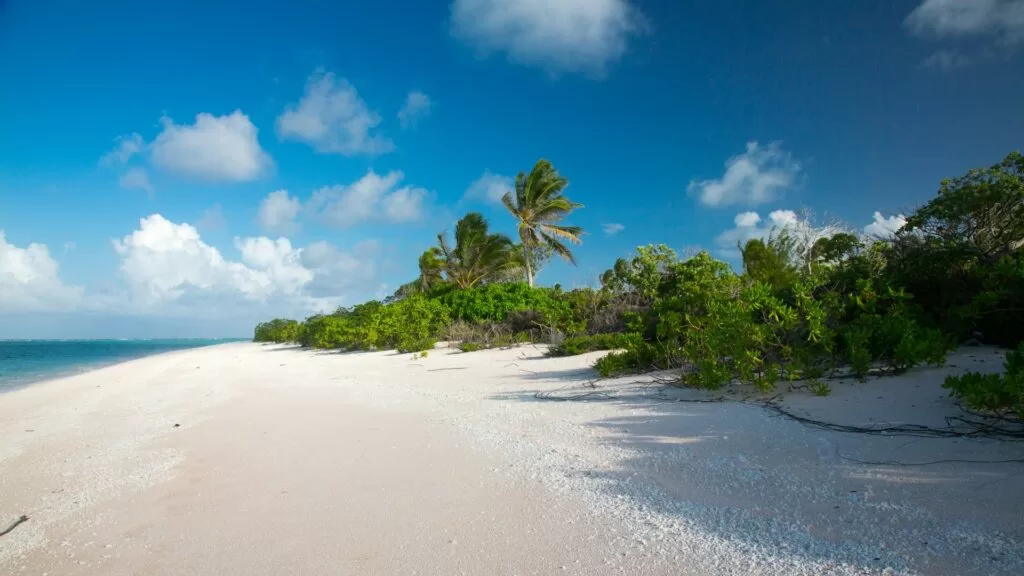Happy Eco News Why the Marshall Islands Marine Sanctuary Matters for Global Conservation
Reading Time: 3 minutes
The Marshall Islands Marine Sanctuary aims to protect vital coral reefs, turtles, and sharks across 48,000 square kilometers of ocean.
The Marshall Islands have just taken a huge step to protect their ocean. The nation has officially designated a new Marshall Islands Marine Sanctuary covering 48,000 square kilometers.
This protected area, which includes the remote northern atolls of Bikar and Bokak, is home to the country’s largest green turtle nesting colony and thriving shark populations.
The Marshall Islands Marine Sanctuary is completely off-limits to fishing, making it a safe haven for marine life. It’s part of the Marshall Islands’ Reimaanlok Conservation Framework, which blends scientific research with traditional knowledge.
The goal? To ensure local communities can manage their natural resources while protecting the ocean for future generations.
A 2023 research expedition led by National Geographic Pristine Seas in partnership with the Marshall Islands Marine Resources Authority (MIMRA) and local scientists studied the biodiversity of Bikar and Bokak. The team conducted scuba dives, dropped underwater cameras, counted seabirds, analyzed environmental DNA, and even used a submarine to explore deep-sea areas.
What they found was stunning. These atolls are among the healthiest ecosystems in the Pacific. The reefs are packed with coral, giant clams, and a wide range of fish species. Scientists also observed rare fish spawning events and mating sharks, proving how vital this habitat is.
Enric Sala, a National Geographic explorer-in-residence, described the atolls as a glimpse into the past. “It’s like diving into an ocean from 1,000 years ago,” he said. “These reefs show us what a thriving marine environment should look like.”
While Bikar and Bokak remain largely untouched, they aren’t immune to climate change. Rising ocean temperatures and acidification pose a serious threat to coral reefs. Nearby Pacific reefs have already suffered from bleaching, a process where corals lose their color and struggle to survive. Scientists fear that continued warming could damage even these resilient atolls.

Sea level rise is another major concern. The Marshall Islands are among the most vulnerable countries in the world, with many of its islands sitting just a few feet above sea level.
Flooding and coastal erosion threaten marine habitats and local communities. By protecting marine ecosystems, the country is conserving biodiversity and securing its future against climate-related disasters.
In addition to protecting wildlife, marine sanctuaries also boost local economies. When fish populations are given space to recover, they spill over into nearby fishing areas, ensuring long-term food security for communities.
Glen Joseph, director of MIMRA, emphasized the balance between conservation and livelihoods. “People think protecting the ocean means losing resources, but it’s the opposite,” he explained. “Healthy marine ecosystems create sustainable fishing opportunities for local communities.”
The Marshall Islands Marine Sanctuary could also attract ecotourism. Scientists, divers, and conservation enthusiasts from around the world may visit to study and experience one of the most untouched ocean environments on Earth. This could create jobs in tourism while raising global awareness about the importance of marine conservation.
Even with protections in place, illegal fishing remains a serious threat in the Pacific. Poachers often target high-value species like tuna and sharks, disrupting marine food chains. The Marshall Islands plans to step up enforcement to protect the sanctuary, using satellite tracking and patrol boats to catch illegal fishers.
Pollution is another challenge. Plastic waste from ships and neighboring countries frequently washes up on these remote islands. This debris harms marine life and threatens the ecosystems the sanctuary is trying to preserve. Strengthening waste management and working with international partners to reduce plastic pollution will be crucial to maintaining the health of these waters.
The Marshall Islands Marine Sanctuary protects one part of the ocean while setting a precedent for global conservation. By combining traditional knowledge with modern science, the country shows the world how to balance environmental protection with economic needs.
As climate change accelerates, more nations may consider this model for guidance. Protecting marine ecosystems isn’t just about preserving nature; it’s about ensuring food security, fighting climate change, and safeguarding livelihoods.
The Marshall Islands is proving that a commitment to the ocean today means a better future for future generations.
The post Why the Marshall Islands Marine Sanctuary Matters for Global Conservation appeared first on Happy Eco News.
